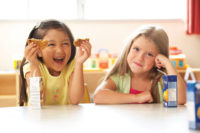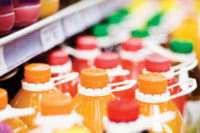Drinks in Schools

That is the result of a pledge, called the School Beverage Guidelines, signed in 2006 by major beverage companies, former President Bill Clinton and health advocacy groups; the pledge outlined calorie content and serving sizes, among other things, for what the companies would send to schools. Lest anyone fear a little of the fox tending the henhouse, the initiative including independent monitoring.
Those monitors, in a study published online in the American Journal of Public Health, say the landscape has shifted dramatically and that industry self-regulation can work to improve public health with the aid of a transparent and independent monitoring program.
The beverage industry pledge came at a time when some state and local regulations had been enacted to restrict which beverages could be sold at schools, and many health advocates were working to publicize sugar-sweetened drinks’ contributions to the obesity epidemic.
For its part, the beverage industry was hearing from consumers “loudly and clearly from, primarily mothers” that they wanted lower-calorie choices, said Susan K. Neely, president and chief executive of the American Beverage Assn.
Under the 2006 memorandum of understanding, serving sizes were reduced from as much as 24oz. to 12oz. in high schools, 10 in middle schools and 8oz. in elementary schools. It called for the elimination of full-calorie sodas from schools. Sports drinks mostly made the calorie cut for high schools of 66 calories in 8oz. In elementary schools, the choices are limited to water, milk and 100% juice.
These products are part of what’s called competitive foods at schools – those that compete for student dollars with the federal meals program. They are sold in vending machines, student stores and in other venues.
So, did the industry do what it said it would?
“In the main, yes it did,” said Robert Wescott, president Keybridge Research, a private econonic research firm in Washington, that was selected to monitor the effort.
“Is it possible that somewhere in America there’s a Coke machine in a hallway where I can put a buck in and get a Coke? Absolutely,” Wescott said. But he added that there has been no “backsliding” since 2010 and the end of the memorandum.
The statistics were not broken down geographically.
Previous self-regulatory efforts in general “spawned a debate among public health professions about whether self-regulation is merely a self-serving tool used by industry to forestall government action or an effective way of responding to market failures,” the journal article says.
Keybridge collected and analyzed data from the 13 largest bottlers nationwide, including proprietary data, to calculate what drinks were shipped to schools.
In 2004, the average high school student bought 12.5oz. of full-calorie soda a week at school, the study said. By 2009-10, the average was 0.4oz. a week, Keybridge found. Younger students by 2010 purchased less than a tenth of an ounce.
In the past, Wescott said, beverage companies had contracts with schools or districts that included upfront contributions or paying for scoreboards, sports equipment, “you name it,” along with revenue sharing of the proceeds from the machines.
“It’s a different business environment now, and these things have pretty much disappeared. Except the revenue sharing, that remains,” Wescott said.
“Our industry is committed to the health and wellness of our nation’s children, and we are proud of what we have accomplished through the School Beverage Guidelines with the Alliance for a Healthier Generation and our school partners,” Neely said.
The changes cost the beverage companies millions of dollars to implement – including reformulating drinks and retrofitting vending machines for new container sizes, Neely said.
“Sales volume is down, and that’s a fact of life,” she said. “That being said, there are many more new products that fit the guidelines.”
In the last decade, she said, soft drink calories have dropped an overall 23%.
The U.S. Dept. of Agriculture is expected to issue rules for competitive foods and drinks sold at schools.
An earlier study in another journal found that in 2010-11, 25% of high school students had access to sugary sodas during school, down down from 54% in 2006-07, with lower figures for younger students. But that counted drinks available through third-party providers who are not part of the agreement, the beverage association said.
Looking for a reprint of this article?
From high-res PDFs to custom plaques, order your copy today!




